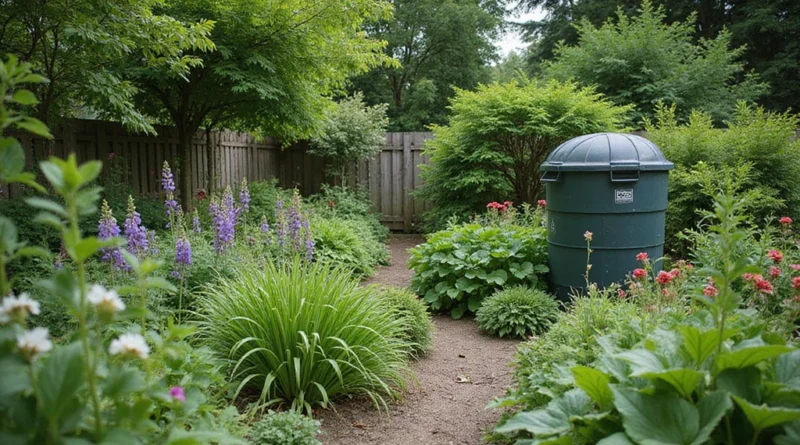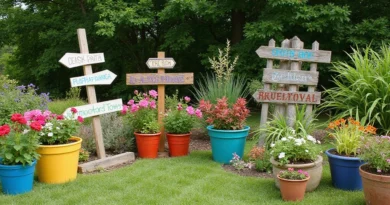Step By Step: How to Embrace Sustainable Gardening for a Greener Future
Gardening isn’t just a hobby; it’s a pathway to nurturing our planet. With sustainable gardening, you cultivate not only your plants but also a healthier ecosystem. This approach is about making smart choices that honor the planet, from choosing the right plants to embracing eco-friendly practices.
From composting to natural pest control, the methods are varied and exciting. The goal is to create a thriving garden that benefits you and the environment. Let’s dig into these sustainable gardening tips that will turn your garden into an eco-friendly haven!
1. Start with Native Plants

Choosing native plants is one of the simplest yet most impactful sustainable gardening tips. These plants are perfectly adapted to your local climate and soil, making them easier to grow and maintain.
By planting native species, you create habitats for local wildlife, including butterflies, bees, and birds. They require less water and fewer pesticides compared to non-native plants, which means you’re saving resources and reducing chemical use. Research local nurseries for native plant options and consider how their colors and textures can enhance your garden’s aesthetic. Here’s a quick list of benefits:
– Less water and maintenance needed.
– Supports local ecosystems.
– Reduces the need for fertilizers and pesticides.
Embracing native plants means you’re saying yes to a more vibrant, diverse, and sustainable garden.
2. Composting: Nature’s Recycling

Composting is like giving your kitchen scraps a second life! It’s an easy eco-friendly practice that recycles organic waste into rich soil.
Start by collecting kitchen scraps like vegetable peels, coffee grounds, and eggshells. Pair these with yard waste like leaves and grass clippings. Layering greens (nitrogen-rich materials) with browns (carbon-rich materials) helps create a balanced compost pile. In a few months, you’ll have nutrient-dense soil to enrich your garden. Here’s why composting rocks:
– Cuts down on landfill waste.
– Enriches garden soil naturally.
– Supports a thriving ecosystem in your garden.
Composting connects you to the earth, turning waste into valuable resources.
3. Water Efficiently

Water conservation is a cornerstone of sustainable gardening. Implementing efficient watering practices not only conserves this precious resource but also enhances plant health.
Consider creating a rain garden or installing a rain barrel to collect rainwater. Drip irrigation systems are excellent for minimizing evaporation and delivering water directly to plant roots. Another tip is to water early in the morning or late in the evening to reduce water loss. Here are some tricks for water-efficient gardening:
– Use mulch to retain moisture.
– Group plants with similar water needs.
– Regularly check for leaks in hoses and irrigation systems.
Taking these steps will ensure your plants thrive while saving water.
4. Embrace Organic Gardening

Going organic is all about using natural methods to grow healthy plants. With organic gardening, you steer clear of synthetic chemicals and focus on nurturing your soil and plants through natural means.
Start by using organic fertilizers, like compost or well-rotted manure, and explore natural pest control methods, such as introducing beneficial insects like ladybugs. Planting companion plants can help deter pests and enhance growth. Benefits of organic gardening include:
– Healthier soil and plants.
– Reduced chemical runoff into local waterways.
– Improved biodiversity in your garden.
Choosing organic is not just a trend; it’s a commitment to a healthier planet.
5. Practice Crop Rotation

Crop rotation is a brilliant way to keep your garden healthy and productive. By changing the types of plants grown in each area of your garden each season, you can reduce soil depletion and pest buildup.
For example, after growing nitrogen-fixing legumes, rotate with leafy greens or root vegetables. This practice enhances soil nutrients and minimizes plant-specific pests and diseases. Here’s why it’s beneficial:
– Maintains soil fertility.
– Breaks pest and disease cycles.
– Encourages biodiversity in the garden.
Implementing crop rotation will keep your garden thriving season after season.
6. Create a Pollinator-Friendly Space

Pollinators are essential to a flourishing garden! Creating spaces that attract bees, butterflies, and hummingbirds not only boosts your garden’s productivity but contributes to local ecosystems.
Plant a variety of nectar-rich flowers and consider adding a bee hotel or butterfly house. Avoid using pesticides, and instead, embrace natural methods for pest control. Here’s how to create a pollinator paradise:
– Choose a variety of flowering plants that bloom at different times.
– Provide water sources with shallow dishes.
– Avoid hybrid plants that lack nectar.
Your pollinator-friendly efforts will yield a vibrant, buzzing garden!
7. Use Sustainable Materials

In sustainable gardening, every choice counts—even the materials you use! Opting for sustainable materials can reduce your garden’s environmental impact significantly.
Choose eco-friendly pots made from biodegradable materials, and consider using reclaimed wood for raised beds or garden structures. Avoid plastic products that contribute to pollution and instead look for alternatives like bamboo or metal. Benefits of using sustainable materials include:
– Reduced waste in landfills.
– Support for eco-friendly companies.
– A garden that looks beautiful and feels good.
Be mindful of your materials, and your garden will reflect your commitment to sustainability.
8. Implement Integrated Pest Management (IPM)

Integrated Pest Management (IPM) is all about smart pest control. Rather than relying solely on pesticides, IPM combines different strategies, including preventive measures and natural solutions, to manage pests effectively.
Start by monitoring your garden regularly to identify any pest issues early. Use barriers, traps, or natural predators to help control pest populations. When necessary, consider using organic pest control methods. Key aspects of IPM include:
– Regular garden inspections.
– Understanding pest life cycles.
– Maintaining healthy plants to resist pests.
With IPM, you create a healthier garden ecosystem while keeping pests in check.
9. Design for Biodiversity

Diversity is key in gardening! A biodiverse garden is not only more resilient but also supports a variety of wildlife. By planting a mix of species, you can create a vibrant ecosystem that can withstand pests and diseases better.
Incorporate a range of plants, including different heights, colors, and types, to create layers and habitats for wildlife. Consider adding native grasses, shrubs, and flowering plants to enhance biodiversity. Benefits of designing for biodiversity include:
– Greater ecosystem resilience.
– Increased aesthetic appeal.
– Support for various wildlife species.
Your diverse garden can become a sanctuary for both you and the local ecosystem.
10. Share Your Knowledge and Garden

One of the most enjoyable aspects of gardening is sharing! Whether it’s giving cuttings to friends, sharing tips, or even starting a community garden, spreading the love for sustainable gardening can inspire others.
Consider hosting workshops or joining local gardening clubs to exchange ideas. You can even start a blog or social media page to document your sustainable journey! Benefits of sharing include:
– Building a community focused on sustainability.
– Learning from others’ experiences.
– Inspiring more people to embrace eco-friendly practices.
Your passion can spark a movement toward a greener future!
Conclusion

Sustainable gardening is about more than just growing plants; it’s a way to nurture the environment. By incorporating these sustainable gardening tips, you can create a vibrant garden that thrives in harmony with nature. Every small change contributes to a larger impact, so start today!
Let your garden reflect your love for the planet and inspire others to do the same.



